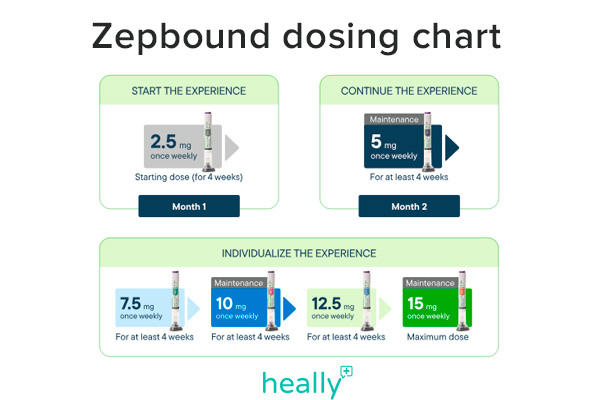In recent months, Zepbound (tirzepatide) weight loss drug has been making waves as the new go-to for shedding those stubborn extra pounds. Anyone with a BMI over 30 knows that traditional weight loss methods don’t always work. Sometimes you need a little extra boost.
Fortunately, Zepbound can be that boost…and more. Boasting an average weight loss of 20.9%, the Zepbound medication is getting a lot of attention.
However, While it may be tempting to give yourself an even bigger head start, you don’t want to get too far ahead of yourself. Safety first, right?
Zepbound Dosage Rules
Proper dosing is key for safe and effective weight loss, especially when it comes to a medication as powerful as Zepbound.
The Zepbound weight loss drug works its magic by targeting multiple metabolic pathways in the body, helping to regulate appetite, gastric emptying, and blood sugar levels—all of which help promote weight loss.
To make dosing easier, these pre-filled, single-dose injector pens come in several dosing options:
- 2.5 mg/0.5 mL
- 5 mg/0.5 mL
- 7.5 mg/0.5 mL
- 10 mg/0.5 mL
- 12.5 mg/0.5 mL
- 15 mg/0.5 mL
Too little and you might not receive the results you’re after. But, too much and you could be in for a rough journey. There is a fine balance.
Above all, It is very important that you stick to the Zepbound dosing schedule outlined by your healthcare provider.
Zepbound Dosage Schedule
The Zepbound dosing schedule is predetermined by Eli Lilly, the manufacturer. You will always begin with the same Zepbound starting dose and increase by 2.5 mg every 4+ weeks until you reach the dose that is right for you.
The right final dose will be determined by you and your healthcare provider.
Zepbound Starting Dose
Zepbound’s lowest dose (2.5 mg) will always be your starting dose. Why?
It allows your body time to adjust to the Zepbound medication and helps to mitigate many of the common side effects. Starting with Zepbound’s lowest dose allows your system time to adjust gradually.
Think of it like a new workout routine—you wouldn’t start with the heaviest weights, right? The same principle applies here.
Zepbound Dosage Chart

The Zepbound dosing schedule is designed to increase at 2.5 mg every 4+ weeks, depending on how your body adjusts to the medication. Remember, your final dose will be determined by you and your healthcare professional, but the Zepbound dosage chart is as follows:
Zepbound Starting Dose |
Zepbound Dosage Increase |
Dosage Schedule |
New Zepbound Dosage |
| 2.5 mg/0.5 mL | +2.5 mg | 4+ weeks | 5 mg/0.5 mL |
| 5 mg/0.5 mL | +2.5 mg | 4+ weeks | 7.5 mg/0.5 mL |
| 7.5 mg/0.5 mL | +2.5 mg | 4+ weeks | 10 mg/0.5 mL |
| 10 mg/0.5 mL | +2.5 mg | 4+ weeks | 12.5 mg/0.5 mL |
| 12.5 mg/0.5 mL | +2.5 mg | 4+ weeks | 15 mg/0.5 mL |
| 15 mg/0.5 mL | N/A | N/A | N/A |
Adjusting Zepbound Doses for Effective Weight Loss
When it comes to maximizing the benefits of Zepbound for weight loss, knowing when and how to adjust your doses is key. There is a reason the schedule states 4 plus weeks.
Because every body is different, their tolerance levels and adjustment period may not be the same. The final schedule is up to you and your healthcare provider.
Why do you gradually adjust your Zepbound dosing?
- To Assess Progress: By starting with Zepbound’s lowest dose and gradually increasing, you can effectively gauge how your body responds to the medication over time. This approach allows you to track your changes more clearly, which can help you determine the effectiveness of the Zepbound medication and the dosage.
- To Monitor Tolerance: Starting low and slowly increasing the Zepbound dosage allows the body to acclimate gradually. The incremental dosage increases over an extended period make it easier to monitor how your body is adjusting to the medication.
- To Minimize Side Effects: Many of the more common side effects will fade as your body adjusts. Gradually increasing the Zepbound dosage can help to reduce the likelihood of experiencing side effects and help to minimize the side effects you do have.
Safety Tips for Zepbound Dosing
Following the Zepbound dosage schedule outlined by your healthcare provider will go a long way. In addition to following the schedule, there are some essential tips to ensure safe and effective Zepbound dosing:
- Know the Potential Side Effects: Familiarize yourself with the possible side effects of Zepbound, which may include nausea, vomiting, diarrhea, and abdominal discomfort. The common side effects are generally mild and temporary, but there are some more serious side effects to watch out for.
- Regular Monitoring by Healthcare Professionals: Stay in touch with your provider throughout your Zepbound journey. Regular check-ins help track progress, adjust treatment, and manage side effects.
- Consult Your Doctor for Dosage Adjustments or Concerns: If you notice strong side effects or slow results, talk to your doctor. They can adjust your dose or suggest other options to improve your plan.
- Practice Open Communication: Be honest about your experience with Zepbound. Share any symptoms, concerns, or changes. If you notice signs of serious side effects, contact your provider right away.
Get Your Zepbound Prescription Online with Heally
To simplify access to care, Heally makes it hassle-free. With virtual consultations and an online pharmacy, you can follow the Zepbound dosing schedule from home.
Just schedule a virtual visit with a healthcare provider. Talk about your weight loss goals and medical history. You’ll receive a personalized Zepbound prescription.
Best of all, there’s no waiting in long pharmacy lines. Your prescription is delivered straight to your door. Staying on track has never been easier.
Schedule your virtual consultation today!
Sources
NEJM: Tirzepatide Once Weekly for the Treatment of Obesity
Eli Lily: Your Weekly Zepbound Routine
WebMD: How Zepbound Works for Weightloss
MedicalNewsToday: Zepbound Dosage Guide and Schedule
Important Medical Information and Disclaimers
Important Current Status Update: On March 19, 2025, the FDA ended enforcement discretion for compounded tirzepatide. Pharmacies may no longer legally compound tirzepatide in most cases, since the FDA confirmed that no drug shortage exists. Patients should use FDA-approved medications like Mounjaro® and Zepbound® unless a provider confirms a medical necessity. Compounding pharmacies do not receive FDA approval for their medications and may introduce different risks compared to FDA-approved drugs.
MEDICAL DISCLAIMER: This information is for educational purposes only and is not intended as medical advice. Zepbound (tirzepatide) is an FDA‑approved prescription medication for chronic weight management and for treating moderate-to-severe obstructive sleep apnea in adults with obesity. Always consult a qualified healthcare provider before starting any treatment.
INDIVIDUAL RESULTS VARY: Results from Zepbound treatment differ between individuals. Outcomes may be influenced by factors such as treatment adherence, lifestyle changes, individual metabolism, growth and development (in adolescents), underlying health conditions, and emotional wellbeing.
IMPORTANT SAFETY INFORMATION:
-
Common side effects: nausea, vomiting, diarrhea, constipation, abdominal pain, indigestion, and injection site reactions.
-
Serious side effects: can include pancreatitis, gallbladder issues, acute kidney injury, low blood sugar (hypoglycemia), and injection site or allergic reactions.
-
Thyroid considerations: Animal studies showed thyroid C‑cell tumors; the relevance to humans is unknown. Zepbound is contraindicated in individuals with a personal or family history of medullary thyroid carcinoma (MTC) or Multiple Endocrine Neoplasia syndrome type 2 (MEN 2).
-
Mental health impacts: Emerging reports suggest mood changes, including depression or suicidal thoughts; providers should monitor mental and emotional health.
COMPOUNDED VERSIONS WARNING: The FDA has issued safety alerts regarding compounded versions of tirzepatide (including from some pharmacies). These formulations may not match the approved medication in quality or efficacy.
FDA ADVERSE EVENT REPORTING: You are encouraged to report negative side effects of prescription drugs to the FDA. Visit FDA MedWatch or call 1‑800‑FDA‑1088.

